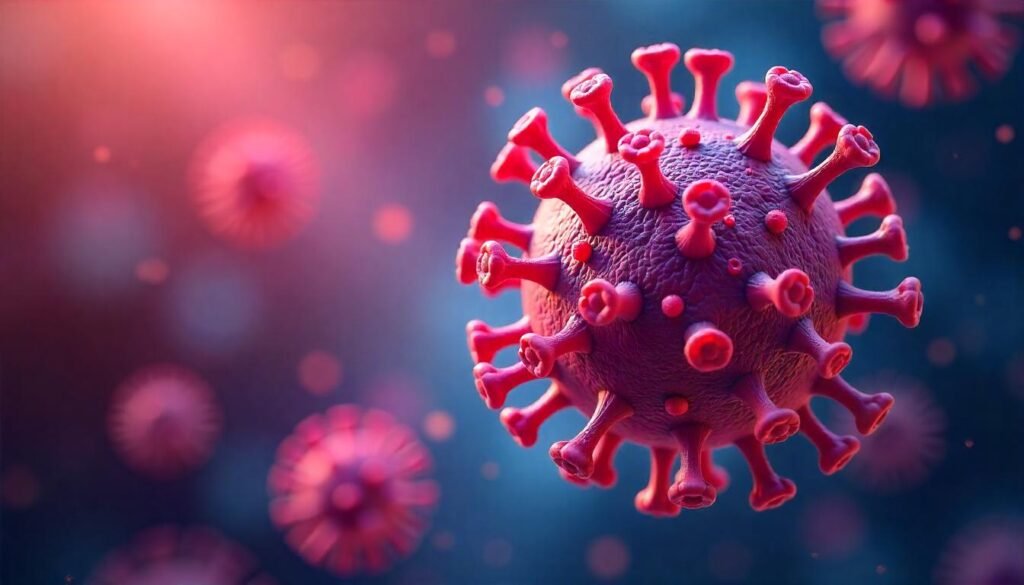Introduction
Human Metapneumovirus (HMPV), is a common respiratory virus that can cause illnesses ranging from a mild cold to more severe conditions like pneumonia. While it can infect individuals of all ages, it poses a more significant threat to young children, older adults, and those with weakened immune systems.
Understanding the nuances of this viral infection is crucial for timely recognition, appropriate management, and effective prevention. This article provides a well-researched, authoritative overview of HMPV, from its symptoms and causes to the latest in treatment and vaccine development.

Table of Contents
Unraveling Human Metapneumovirus (HMPV)
Human Metapneumovirus is a member of the Pneumoviridae family, making it a close relative of the more widely known Respiratory Syncytial Virus (RSV). Since its discovery in 2001, HMPV has been recognized as a significant respiratory pathogen worldwide. The virus typically circulates in the late winter and spring months, often contributing to seasonal spikes in respiratory illnesses.
Most people will have been infected with HMPV by the age of five, and reinfections can occur throughout life. While initial infections in childhood can be more severe, subsequent infections in healthy individuals are often milder, resembling the common cold.

The Telltale Signs: Human Metapneumovirus Symptoms
The symptoms of HMPV can vary in severity and often mimic those of other respiratory infections. The incubation period for HMPV is typically 3 to 6 days.
Common Symptoms in Adults and Older Children:
- Cough: Often a prominent and persistent symptom.
- Runny or stuffy nose: Similar to a common cold.
- Sore throat: A frequent early sign of infection.
- Fever: Can range from low-grade to high.
- Headache and body aches: General feelings of malaise.
HMPV Infection in Children: Human metapneumovirus (HMPV) infections can pose a greater threat to young children, and infants in particular, making them more vulnerable to experiencing severe illness as a result of the virus.
Because of their still-developing immune systems, young children and babies are more likely to suffer serious complications from HMPV.
The initial symptoms of an HMPV infection may worsen and advance into more serious conditions affecting the lower respiratory tract. This progression can lead to the development of lower respiratory tract diseases, which can be particularly dangerous for this vulnerable age group.
- Wheezing: A high-pitched whistling sound during breathing.
- Shortness of breath: Difficulty in breathing, which may be rapid.
- Irritability and poor feeding: In infants, these can be key indicators of illness.

When HMPV Becomes Serious: Complications
In some individuals, particularly those in high-risk groups, HMPV can lead to more severe complications that may require hospitalization.
HMPV and Bronchiolitis
Bronchiolitis is a condition characterized by inflammation affecting the small airways in the lungs, which are known as bronchioles.
This inflammation can cause a variety of respiratory symptoms and is frequently observed as a complication arising from Human Metapneumovirus (HMPV) infection, particularly in young children.
Bronchiolitis is most commonly seen in children who are under two years of age, making this age group particularly susceptible to the condition following an HMPV infection. The symptoms of bronchiolitis can include rapid breathing, which may be noticeable as an increased rate of respiration. Wheezing, a whistling sound during breathing, is another common symptom. Additionally, a persistent cough, one that lasts for an extended period, is also characteristic of bronchiolitis.

HMPV and Pneumonia
Pneumonia is an infection that inflames the air sacs in one or both lungs. HMPV is a recognized cause of viral pneumonia, particularly in young children, the elderly, and immunocompromised individuals. Symptoms can include a severe cough with phlegm, high fever, chills, and difficulty breathing.
How is Human Metapneumovirus Spread?
HMPV is a contagious viral infection that spreads through:
- Respiratory droplets: The transmission of illness can occur through the respiratory droplets expelled from the body of someone who is infected. These droplets, released during actions such as coughing and sneezing, carry the infectious agents that can spread the disease to others.
- Direct contact: An example of a way the virus could be transmitted is through physical contact, such as the act of shaking hands. This could occur if the person you are shaking hands with is infected with the virus and has it present on their hands.
- Indirect contact: The transmission of germs can occur when individuals come into contact with surfaces that have been contaminated, such as frequently touched objects like doorknobs or children’s toys.
- Subsequently, if a person touches their face, specifically their mouth or eyes, after contacting these contaminated surfaces, they risk transferring the germs from the surface to their own body.
- This process of touching contaminated objects and then touching one’s face, mouth, or eyes creates a pathway for germs to enter the body and potentially cause illness.
Diagnosing HMPV: Identifying the Culprit
Since the symptoms of HMPV are similar to other respiratory viruses, a definitive diagnosis often requires laboratory testing. Healthcare providers may suspect HMPV based on the patient’s symptoms and the time of year.
The most common and accurate method for diagnosing HMPV is a reverse transcription-polymerase chain reaction (RT-PCR) test. This test detects the genetic material of the virus from a respiratory sample, usually obtained through a nasal or throat swab.
Treatment and Management of HMPV Infection
Currently, there is no antiviral medication specifically designed to combat Human metapneumovirus (HMPV). As a result, the approach to managing HMPV infections centers largely on supportive care.
This means that medical interventions are aimed at alleviating the various symptoms that arise from the infection. Furthermore, treatment strategies prioritize the prevention of secondary complications that may develop as a consequence of HMPV.
The focus is on making the patient comfortable and helping the body to naturally fight off the virus, while also taking measures to minimize the risk of further health issues.
At-Home Care:
- Rest: Ample rest helps the body fight the infection.
- Hydration: Drinking plenty of fluids, like water, juice, and broth, can prevent dehydration and help thin mucus.
- Over-the-counter medications: Pain relievers and fever reducers like acetaminophen or ibuprofen can help manage symptoms. Decongestants may be used in older children and adults. Always consult a healthcare professional before giving any medication to a child.
- Humidifier: Using a cool-mist humidifier can help soothe a sore throat and ease congestion.
Hospital-Based Care: When a person experiences a severe case of Human Metapneumovirus (HMPV) infection, it might become essential for them to be admitted to a hospital for more intensive care and monitoring.
The need for hospitalization arises when the infection’s symptoms and effects are too significant to be managed effectively at home or in an outpatient setting. While the patient is receiving care within the hospital environment, the treatment plan could encompass various medical interventions and supportive therapies.
These treatments are specifically designed to alleviate the symptoms, manage any complications that may arise, and ultimately support the patient’s recovery from the HMPV infection. The interventions administered in a hospital setting may include, but are not limited to:
- Intravenous (IV) fluids: To combat dehydration.
- Supplemental oxygen: To assist with breathing difficulties.
- Mechanical ventilation: In life-threatening cases of respiratory failure.
Prevention: Guarding Against HMPV
To effectively prevent the spread of Human Metapneumovirus (HMPV) and other respiratory infections, it is essential to consistently practice good hygiene habits.
These practices play a crucial role in minimizing the transmission of these viruses from person to person, thereby safeguarding public health.
By adhering to proper hygiene protocols, individuals can significantly reduce their risk of contracting and spreading respiratory illnesses, including HMPV.
Key Preventive Measures:
- Frequent handwashing: Wash your hands often with soap and water for at least 20 seconds. If soap and water are not available, use an alcohol-based hand sanitizer.
- Avoid touching your face: Refrain from touching your eyes, nose, and mouth with unwashed hands.
- Cover your coughs and sneezes: Use a tissue or your elbow to cover your mouth and nose when you cough or sneeze.
- Clean and disinfect surfaces: Regularly clean frequently touched surfaces like countertops, doorknobs, and toys.
- Avoid close contact with sick individuals: If you or someone you know is sick, try to maintain a safe distance to prevent transmission.
The Quest for an HMPV Vaccine
Currently, there is no vaccine available to prevent Human Metapneumovirus. However, the significant health burden of this viral infection has spurred research and development efforts. Scientists are actively working on creating a safe and effective HMPV vaccine.
The development of successful vaccines for RSV has provided valuable insights and renewed optimism for the future of HMPV vaccine development.
HMPV vs. RSV: Understanding the Differences
HMPV and RSV are often mentioned together due to their similarities. Both are major causes of respiratory illness, especially in children.
| Feature | Human Metapneumovirus (HMPV) | Respiratory Syncytial Virus (RSV) |
| Virus Family | Pneumoviridae | Pneumoviridae |
| Peak Season | Late winter and spring | Fall and winter |
| Primary Age Group | Young children, but can infect all ages | Infants and young children |
| Common Complications | Bronchiolitis, pneumonia | Bronchiolitis, pneumonia |
| Vaccine | In development | Available for older adults and pregnant individuals |
Export to Sheets
Conclusion: Navigating HMPV with Knowledge
Human Metapneumovirus is a prevalent respiratory pathogen that can cause a spectrum of illnesses. While most infections are mild and self-resolving, it is essential to be aware of the potential for severe disease, especially in vulnerable populations.
Recognizing the symptoms, understanding how the virus spreads, and practicing preventive measures are key to mitigating its impact.
If you or a loved one experiences severe symptoms or you have concerns about a respiratory illness, it is crucial to talk to your doctor or another healthcare professional for an accurate diagnosis and appropriate treatment plan.
Frequently Asked Questions (FAQs)
1. What is the difference between HMPV and a common cold? While many HMPV infections present with symptoms similar to a common cold (runny nose, sore throat, cough), HMPV has the potential to cause more severe lower respiratory tract infections like bronchiolitis and pneumonia, especially in young children and older adults. A definitive diagnosis requires laboratory testing.
2. Is there a vaccine for Human Metapneumovirus (HMPV)? No, there is currently no vaccine available for HMPV. However, research into HMPV vaccine development is ongoing, with promising advancements in the field of respiratory virus vaccines.
3. How is HMPV treated? There is no specific antiviral treatment for HMPV. Management is supportive and focuses on relieving symptoms. This includes rest, staying hydrated, and using over-the-counter medications to manage fever and pain. In severe cases, hospitalization for oxygen support and other interventions may be necessary.
4. Can you get HMPV more than once? Yes, reinfection with HMPV is common throughout life. The initial infection, usually in early childhood, tends to be the most severe. Subsequent infections are typically milder in healthy individuals due to some level of immunity.
5. When should I see a doctor for HMPV symptoms? You should see a doctor if you or your child experiences severe symptoms such as difficulty breathing, high fever, wheezing, or if symptoms worsen or do not improve after a few days. Individuals in high-risk groups (infants, older adults, and those with weakened immune systems) should seek medical attention promptly if they develop respiratory symptoms.



